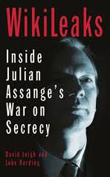 Leigh, David & Harding, Luke - WikiLeaks: Inside Julian Assange's War on Secrecy, Guardianbooks, London, 2011, pp.340 ISBN 978-0-85265-239-8
Leigh, David & Harding, Luke - WikiLeaks: Inside Julian Assange's War on Secrecy, Guardianbooks, London, 2011, pp.340 ISBN 978-0-85265-239-8
The role of The Guardian in the WikiLeaks saga was and is central to many of its celebrated episodes and dramas. The Guardian, a longstanding left-oriented newspaper, had become a global news distributor through both The Guardian Weekly and then with a robust on-line presence through its various blogs, website and then apps. It is fitting then that this narrative about WikiLeaks would be one of the first out of the blocks and with sufficient cred to have insider status on a number of the twists and turns that make up the still unfolding story of the whistleblower website and the changes wrought to the 21st century mediascape.
The Guardian had history with WikiLeaks. In 2008-9, with UK judges banning the publication of documents relating to Barclays (tax avoidance strategies) and the Trigafura incident (toxic dumping), WikiLeaks set up the contradiction that, with its publications about these incidents on the web, the material was in the public domain allowing other media outlets like The Guardian to republish and develop the stories. It was The Guardian, then, that made the most of this extraordinary change to the way legal sanction against certain news stories could be circumvented. And as one could say, “the rest was history” … The Guardianbooks narrative developed by David Leigh and Luke Harding with assistance from Ed Pilkington, Robert Booth and Charles Author, pick up the story most emphatically with the so-called “Collateral Murder” video (the massacre of Iraqi civilians by an American Apache Battalion in Iraq in 2007).
The most telling aspect of this narrative is that it is founded in this moment of raw footage and sometimes hotly debated questions (both inside and outside WikiLeaks) as to the appropriateness of the way this material was released by WikiLeaks. Consider that in 2009, a book penned by Pulitzer prize-winning journalist, David Finkle titled, The Good Soldiers, described this incident in minute detail – within the deep context offered by an embedded journalist. Despite the very cogent critiques offered of embedded journalism, this book does well to provide what the “Collateral Murder” video could not – detailed and personal accounts about combat by those at the coal face. However, of the 334 reviews of the book found at http://www.goodreads.com/book/show/6633912-the-good-soldiers, few if any connect Finkle’s work with the WikiLeaks release. This is more extraordinary for reviews written after the release (2010-2011) of the video.
The point is that this moment of the “Collateral Murder” release galvanises the whole WikiLeaks intervention in news, in war reporting and in its attack on secrecy, especially military secrets. So, it is fitting for The Guardian authors (as with many other accounts) to place this moment so prominently in the narrative arc of the WikiLeaks story. From here, the story is now familiar to many, however it is The Guardian authors who can tell best the inside story of the collaboration between itself and then other major news organisations with WikiLeaks. This change in the model for the WikiLeaks website was the point at which its material became mainstream and those hanging out with the whistleblowers from its early days would have truly wondered what in blazes had occurred. Where few have dared tread, now a veritable herd of news agents and agencies could not get enough of WikiLeaks’ material. And so emerged a very significant change to journalistic practices – and with it many questions that remain unanswered concerning the lines – now very blurred between sources, publishers and media outlets.
One of the clues that this treatment of the WikiLeaks gives away is its chapter breakdown followed by a heading: Cast of Characters. This goes on for five pages with characters aligned with various parts of the world where the story has had parts of its drama unfold. What this book does best is give the WikiLeaks the soap operatic treatment it thoroughly deserves – but as a real page-turner, it suggests that it was working with great material. With a section of selected embassy cables and a well developed index, this book is also a good ‘beginner’s guide’ to the content provided by WikiLeaks should readers wish to go beyond the drama and sample the material for themselves. Highly recommended for the faithful and critics alike.
About the Reviewer
Hart Cohen is Associate Professor in the School of Communication Arts, University of Western Sydney. He is also an editor of Global Media Journal, Australian edition, He has followed the WikiLeaks saga from 2009 and first presented on WikiLeaks in September 2010 in a paper titled, “WikiLeaks, Journalism to Die For”, Guest Lecture, Masters of Journalism, Simon Fraser University in Canada.

